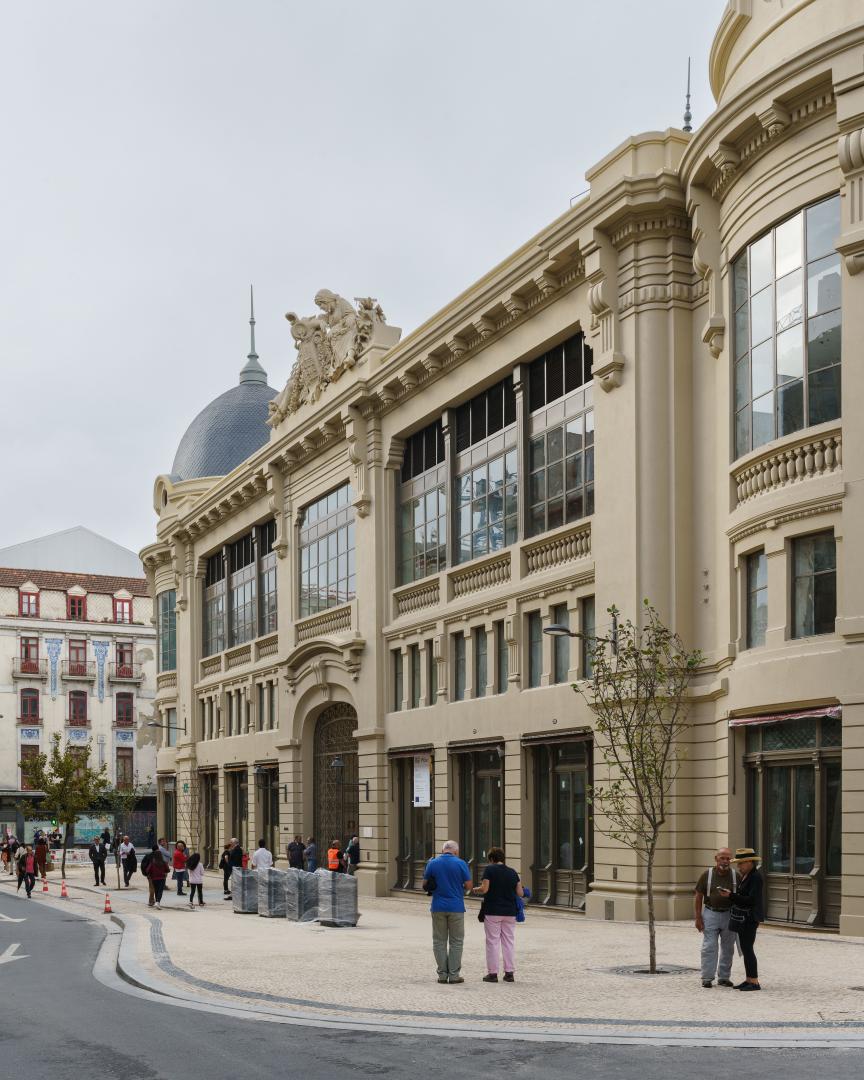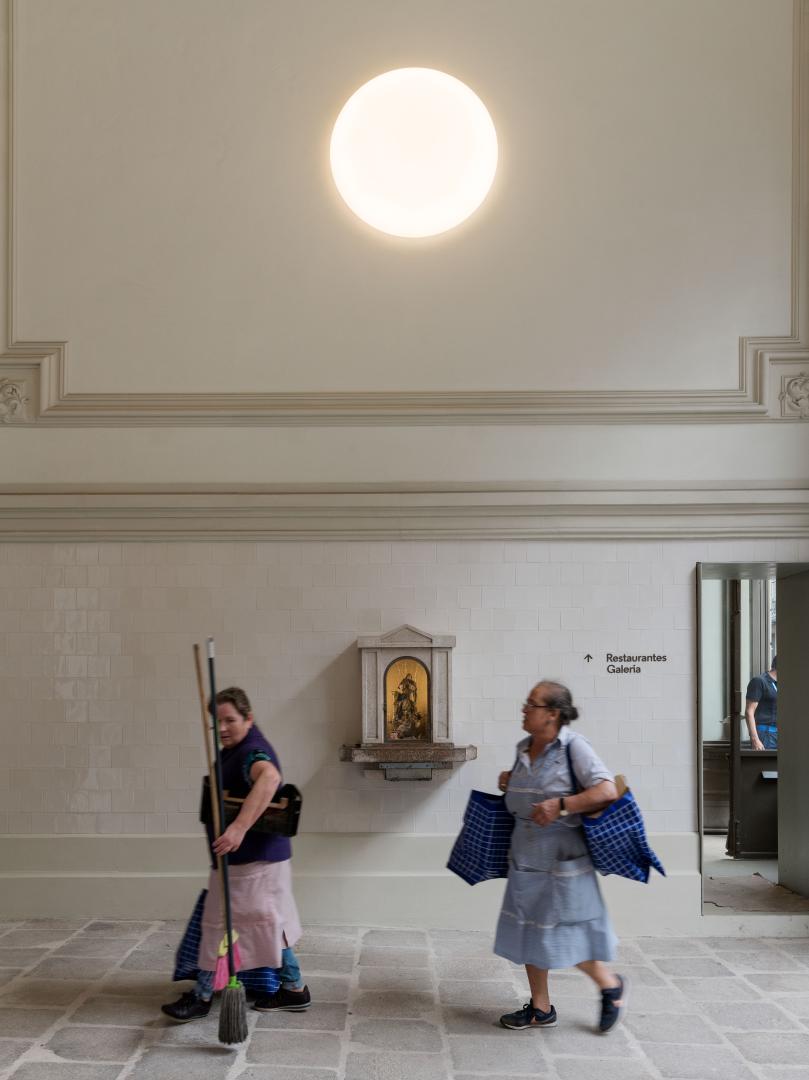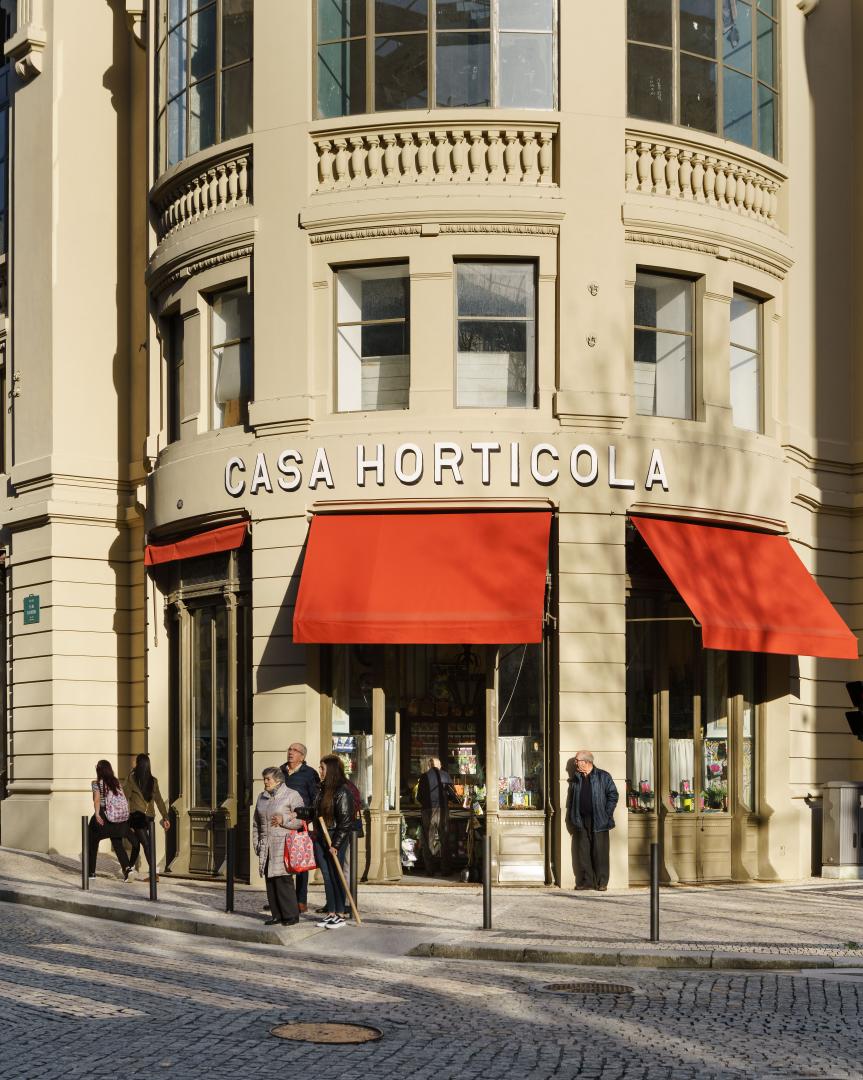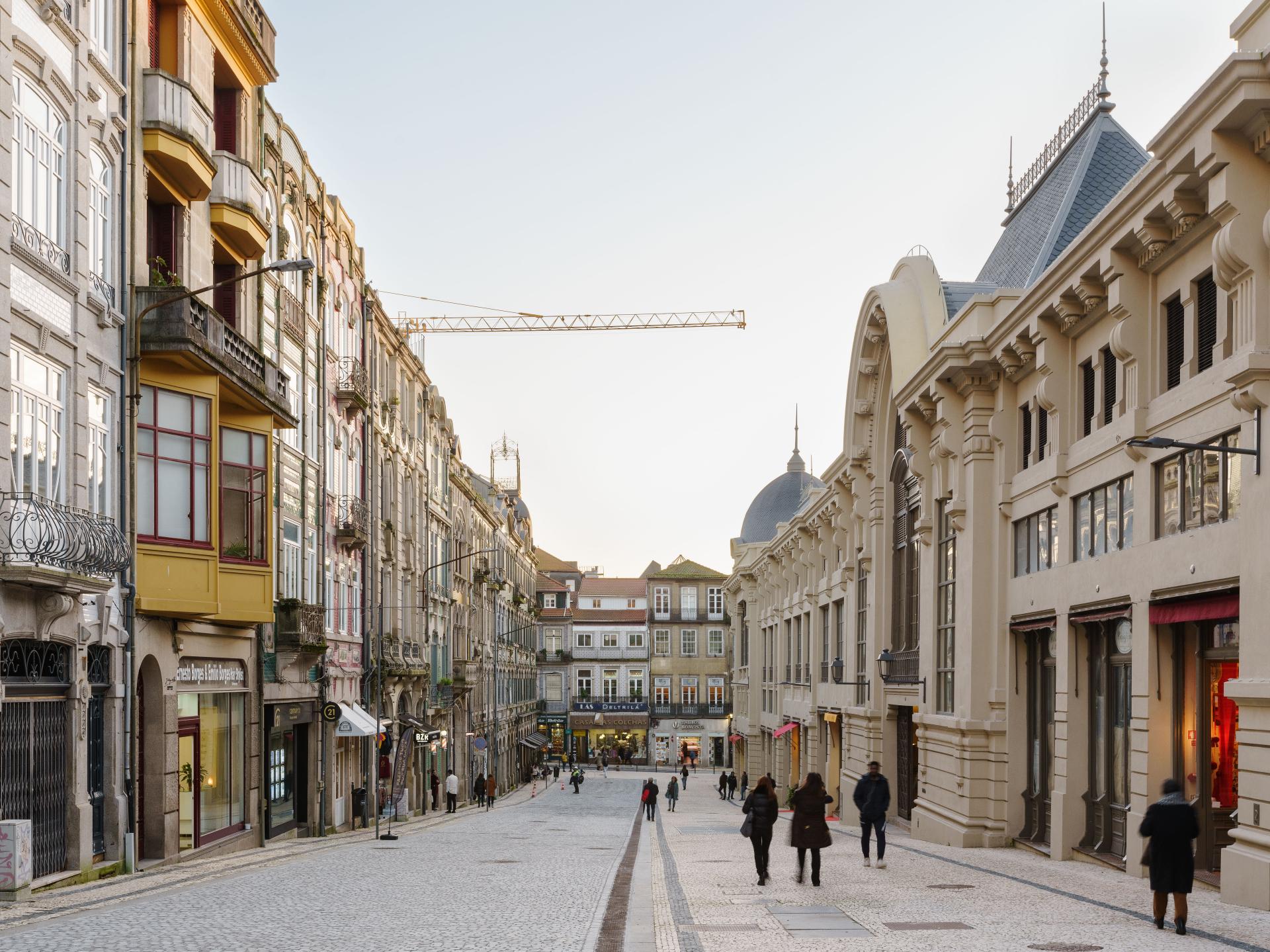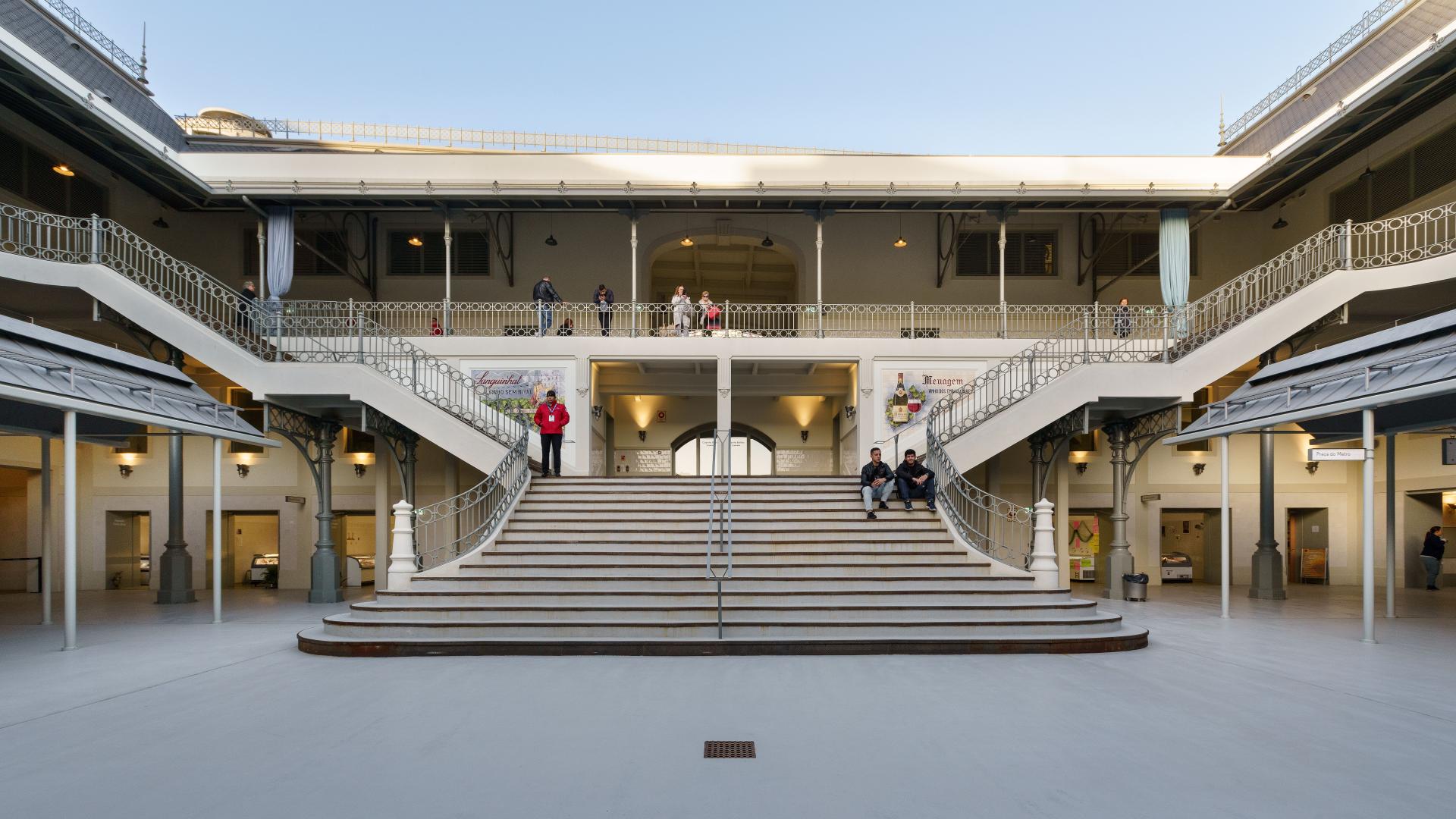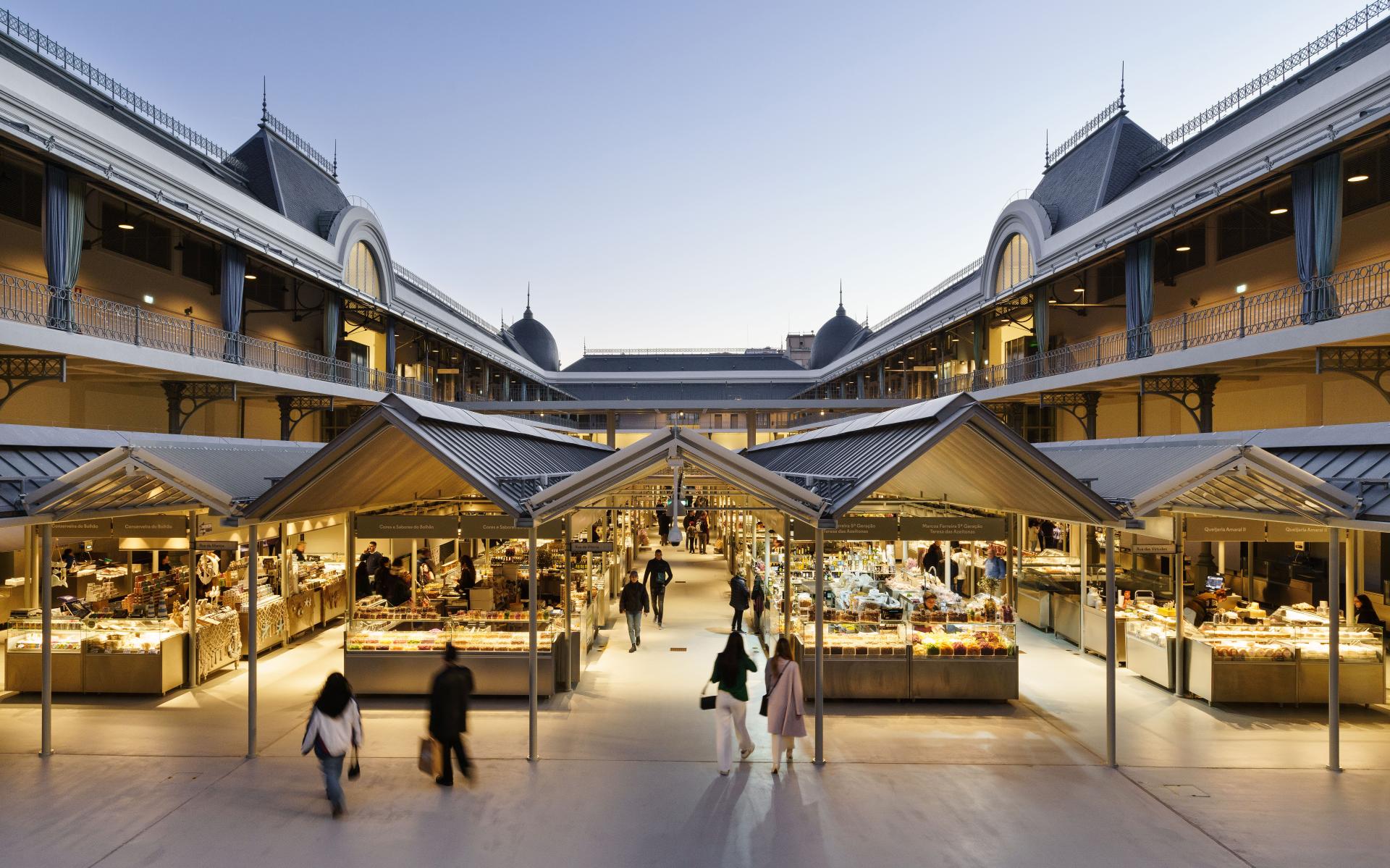Mercado do Bolhão
Basic information
Project Title
Mercado do Bolhão
Full project title
Restoration and Modernization of Mercado do Bolhão
Category
Regaining a sense of belonging
Project Description
Mercado do Bolhão is a unique building, part of the memory and identity of Porto’s people. The project, attentive to the existing heritage, aims to enhance the identity and coherence, removing spurious elements and managing new infrastructures without losing its central values - sellers, users and the fresh market activity.
Geographical Scope
Local
Project Region
Porto, Portugal
Urban or rural issues
Mainly urban
Physical or other transformations
It refers to a physical transformation of the built environment (hard investment)
EU Programme or fund
Yes
Which funds
Other
Other Funds
NORTE 2020<br />
PORTUGAL 2020<br />
ERDF : European Regional Development Fund
Description of the project
Summary
Historic central urban markets are experiencing a period of transformation. On the one hand, they are generally over dimensioned for their current demand, due to the growing success of department stores and consequent abandonment of markets. On the other hand, they require a profound actualization and the recuperation of their identity and values: people, relationships, and the architectural quality of the original buildings. Bolhão is no exception, finding itself in a very derelict, adulterated and functionally misadjusted condition. Thus, since 1990, the Porto City Council has four times tried to renovate it.
The Bolhão’s Market is classified as a “monument of public interest”, recognizing its heritage value in two inseparable dimensions: the uniqueness of the Beaux-Arts building and its function as a traditional market.
The intervention is based on restoring and enhancing the existing building, designed in 1914/17 by Correia da Silva, and its modernization to meet contemporary functional requirements, altering only what’s required in the market’s renovation process, through a careful balance between material and immaterial values.
This transforming action, respectful of the existing heritage, aims to reinforce the building’s identity and coherence, eliminating spurious elements and adding new infrastructure without losing its distinctive characteristic elements: vendors, users and the activity of the fresh market.
The project’s strategy is therefore based on 3 main principles:
I. The physical renovation of the building, restoring its lost coherence and identity;
II. The updating of the fresh produce market, turning it into a referential market;
III. The restitution of the relationship between this building and the city, increasing transparency, accessibility, articulation, comfort, hygiene and functionality.
The Bolhão’s Market is classified as a “monument of public interest”, recognizing its heritage value in two inseparable dimensions: the uniqueness of the Beaux-Arts building and its function as a traditional market.
The intervention is based on restoring and enhancing the existing building, designed in 1914/17 by Correia da Silva, and its modernization to meet contemporary functional requirements, altering only what’s required in the market’s renovation process, through a careful balance between material and immaterial values.
This transforming action, respectful of the existing heritage, aims to reinforce the building’s identity and coherence, eliminating spurious elements and adding new infrastructure without losing its distinctive characteristic elements: vendors, users and the activity of the fresh market.
The project’s strategy is therefore based on 3 main principles:
I. The physical renovation of the building, restoring its lost coherence and identity;
II. The updating of the fresh produce market, turning it into a referential market;
III. The restitution of the relationship between this building and the city, increasing transparency, accessibility, articulation, comfort, hygiene and functionality.
Key objectives for sustainability
If we aspire to the best environmentally conscious design practices, there is no greater environmental criteria than the reintegration of as much existing materials as possible. Preservation and critical, adaptive reintegration of the existing materials were the sustainable principles followed by this project.
In addition, the choice for using passive thermal performance principles - thus avoiding a major energy effort in producing climatized air for such a space of this size – was another principle. Therefore, by deciding to keep the market uncovered at the higher level:
- the traditional shading curtains along the gallery balcony were reinterpreted;
- a roof, strongly ventilated along the ridges (with both natural and mechanical ventilation) and shaded on the transparent wings by adjustable blades, was designed at the terrace level, ensuring only zenith light on the glass surfaces and therefore increasing better preservation of the products’ quality and of the comfort for users.
In addition, the choice for using passive thermal performance principles - thus avoiding a major energy effort in producing climatized air for such a space of this size – was another principle. Therefore, by deciding to keep the market uncovered at the higher level:
- the traditional shading curtains along the gallery balcony were reinterpreted;
- a roof, strongly ventilated along the ridges (with both natural and mechanical ventilation) and shaded on the transparent wings by adjustable blades, was designed at the terrace level, ensuring only zenith light on the glass surfaces and therefore increasing better preservation of the products’ quality and of the comfort for users.
Key objectives for aesthetics and quality
Mercado do Bolhão is a space with its own character, asserting itself as an important identity asset of the city. Its urban presence, typological solution, spatial quality, construction system and unique identity resulting from its function as a market — from sellers to buyers, from relationships to memories — make of it a reference in the city of Porto. Occupying an entire block in the centre of the city, the Market is a crucial structuring element in one of the most dynamic areas of Porto’s urban fabric, as maximum expression of its traditional commerce, with a significant flow of users, such as salespeople, local customers, and visitors.
This work reconciles the city with the traditional market, profoundly improves its urban setting (by solving the logistics of loading goods without disturbing the surrounding streets), reprograms and resizes the market allowing the galleries to be an extension of the public space and a stage for various events. Thus, it promotes an intense cultural dimension, densifying the user’s experience. Such a diversified program includes, for instance, the following initiatives:
- the establishment of partnerships with academic and institutional entities;
- events following a strategy based on the areas of arts & entertainment, agri-food, brand activations and special programmes, such as musical concerts, exhibitions and lectures;
- the use of demonstrative pedagogical cooking by schools, chefs e workshops, which contributes towards food literacy and promotes the market as a way to shrink the distance between producers and users, providing direct knowledge of the products and their seasonality. As part of this scope is the creation of the “Health Days in Bolhão” program in a perspective of social responsibility involving 5 to 9 years old students from several schools from metropolitan Porto and the community in general.
This work reconciles the city with the traditional market, profoundly improves its urban setting (by solving the logistics of loading goods without disturbing the surrounding streets), reprograms and resizes the market allowing the galleries to be an extension of the public space and a stage for various events. Thus, it promotes an intense cultural dimension, densifying the user’s experience. Such a diversified program includes, for instance, the following initiatives:
- the establishment of partnerships with academic and institutional entities;
- events following a strategy based on the areas of arts & entertainment, agri-food, brand activations and special programmes, such as musical concerts, exhibitions and lectures;
- the use of demonstrative pedagogical cooking by schools, chefs e workshops, which contributes towards food literacy and promotes the market as a way to shrink the distance between producers and users, providing direct knowledge of the products and their seasonality. As part of this scope is the creation of the “Health Days in Bolhão” program in a perspective of social responsibility involving 5 to 9 years old students from several schools from metropolitan Porto and the community in general.
Key objectives for inclusion
The first objective has been accomplished with the project’s construction, after four attempts started 30 years ago. This project has benefited from the knowledge acquired with the previous proposals, which embodied very distinctive visions of the city and of the municipal market. However, for the first time there has been a total political consensus about this project and its urgency. This project stands out for its political and technical "culture of decision". The diagnosis, methodology and project were based on the courageous determination to maintain the fresh produce market and its vendors, holders of the "heritage of relationship". From a one-to-one survey about their context and needs to the temporary market, which reactivated the “Bolhão” brand throughout 4 years and prepared everyone's return, the process became an example at national and international levels. The new figures are impressive: there has been a huge increase in visitors - 6 times more, an average of 20,000 a day since the opening - in addition to the increase in vendors.
Some principles followed in the Market's renovation project strengthened its connection with the local community and with the surroundings:
- The entire renovation of this city area, together with the solution for accessing the Logistics Basement (a tunnel), opened the possibility for pedestrianizing Rua Alexandre Braga, thus pursuing a broader strategy in the city management.
- The direct connection of the Terrace to the Bolhão Metro Station, offering a new gateway, represents an important improvement in terms of accessibility and usage of the Market in both directions: enhancing its own activity and that of public transport.
- The Market’s Square, Gallery, and Northern Staircase made available as an open public space expands the possibilities for cultural appropriation: numerous events have taken place in these spaces, such as gastronomy festivals and music concerts.
Some principles followed in the Market's renovation project strengthened its connection with the local community and with the surroundings:
- The entire renovation of this city area, together with the solution for accessing the Logistics Basement (a tunnel), opened the possibility for pedestrianizing Rua Alexandre Braga, thus pursuing a broader strategy in the city management.
- The direct connection of the Terrace to the Bolhão Metro Station, offering a new gateway, represents an important improvement in terms of accessibility and usage of the Market in both directions: enhancing its own activity and that of public transport.
- The Market’s Square, Gallery, and Northern Staircase made available as an open public space expands the possibilities for cultural appropriation: numerous events have taken place in these spaces, such as gastronomy festivals and music concerts.
Results in relation to category
The recovering of the building's lost original matrix is itself a very impactful result in the city’s activity and in the lives of its beneficiaries, notably in their sense of identity and belonging to the city.
As regards to updating – essential “aggiornamento” for the present and future needs of this facility - we highlight 4 transformative and impactful aspects:
- the construction of the Logistics Basement accessed through a low-level tunnel, thus freeing up the surrounding area close to the Market from access ramps and from other constraints linked to loading and unloading activities;
- the replacement of the concrete bridge (1940s) by a new uncovered, two-level metal walkway, making it possible to understand the original contour of the Market and providing the city with a new street. This action promotes better accessibility to the Market and the pedestrianization of the surrounding streets (such as recently in Rua Alexandre Braga);
- the reinterpretation of the new stall structures, complying with the fundamental principle of continuity of the project solution.
- the direct connection of the Market terrace to the Bolhão Metro Station piers;
Alongside these results, with a direct impact in the users of the Market and of the City, there are numerous cultural activities organized, which promote a remarkable interaction, attracting all kinds of large scale audiences – six times increase in visitors with an average of 20,000 per day since the opening.
The Market’s impact and the sense of belonging and cultural identity of its users are also evidenced by its regular presence in the media: more than 2,000 mentions in the news since its reopening.
At last, we emphasize the growing scientific results, confirmed by the publishing of a SbO (FEUP) magazine issue, 5 scientific articles, a PhD thesis in progress, as well as 2 documentaries and 2 books in press, authored by Porto City Council and Nuno Miguel Borges, respectively.
As regards to updating – essential “aggiornamento” for the present and future needs of this facility - we highlight 4 transformative and impactful aspects:
- the construction of the Logistics Basement accessed through a low-level tunnel, thus freeing up the surrounding area close to the Market from access ramps and from other constraints linked to loading and unloading activities;
- the replacement of the concrete bridge (1940s) by a new uncovered, two-level metal walkway, making it possible to understand the original contour of the Market and providing the city with a new street. This action promotes better accessibility to the Market and the pedestrianization of the surrounding streets (such as recently in Rua Alexandre Braga);
- the reinterpretation of the new stall structures, complying with the fundamental principle of continuity of the project solution.
- the direct connection of the Market terrace to the Bolhão Metro Station piers;
Alongside these results, with a direct impact in the users of the Market and of the City, there are numerous cultural activities organized, which promote a remarkable interaction, attracting all kinds of large scale audiences – six times increase in visitors with an average of 20,000 per day since the opening.
The Market’s impact and the sense of belonging and cultural identity of its users are also evidenced by its regular presence in the media: more than 2,000 mentions in the news since its reopening.
At last, we emphasize the growing scientific results, confirmed by the publishing of a SbO (FEUP) magazine issue, 5 scientific articles, a PhD thesis in progress, as well as 2 documentaries and 2 books in press, authored by Porto City Council and Nuno Miguel Borges, respectively.
How Citizens benefit
Since the beginning of the 19th century - at the time still an open square in the city (1837, Costa Lima Júnior) - the Bolhão Market has been a fundamental and foundational space in the city of Porto. With a strong character and full of meaning, it establishes a clear sense of belonging and identity with the population - confirmed by the Ordinance 613/2013, which classifies the building for its material and immaterial values (the market's and its relationships).
Therefore, it wouldn't have been possible for the renovation project of the Mercado building to not have been strongly debated and participated in by national civil society, from the first proposal to renovate the building (1992) to the proposal that was finally implemented (2022), which, for the first time, brought together an absolute political consensus between the city government and its opposition. In these several decades of history, there have even been moments of strong public protest (real estate development project handed over to a Dutch company, 2008).
In this sense, the large process of rehabilitation of the Bolhão Market would have to mandatorily involve an inclusive and participatory governance, with a very close approach to people and their relationships (the intangible values that were to be maintained). The City Council therefore created its own office to coordinate the whole process. It carried out a careful socio-economic diagnosis - with a detailed survey of the context and needs of each vendor; prepared the relocation to the Temporary Market; promoted the activation of the "Bolhão" brand and, finally, accompanied the installation of the vendors in the renovated market.
Thus, we can say that the participation of direct and indirect beneficiaries in this process was not just one part of the equation, but definitely a guiding principle of the overall strategy of the Porto Market Rehabilitation Process.
Therefore, it wouldn't have been possible for the renovation project of the Mercado building to not have been strongly debated and participated in by national civil society, from the first proposal to renovate the building (1992) to the proposal that was finally implemented (2022), which, for the first time, brought together an absolute political consensus between the city government and its opposition. In these several decades of history, there have even been moments of strong public protest (real estate development project handed over to a Dutch company, 2008).
In this sense, the large process of rehabilitation of the Bolhão Market would have to mandatorily involve an inclusive and participatory governance, with a very close approach to people and their relationships (the intangible values that were to be maintained). The City Council therefore created its own office to coordinate the whole process. It carried out a careful socio-economic diagnosis - with a detailed survey of the context and needs of each vendor; prepared the relocation to the Temporary Market; promoted the activation of the "Bolhão" brand and, finally, accompanied the installation of the vendors in the renovated market.
Thus, we can say that the participation of direct and indirect beneficiaries in this process was not just one part of the equation, but definitely a guiding principle of the overall strategy of the Porto Market Rehabilitation Process.
Physical or other transformations
It refers to a physical transformation of the built environment (hard investment)
Innovative character
The most innovative aspect that stands out is the political decision to maintain the fresh produce market as the main feature of the renovated Bolhão. There are currently seventy-nine stalls selling fresh products (meat, fish, vegetables, fruits, and flowers), a unique large-scale sales offer in the historic centre of Porto. Still within the scope of food products, the renovation of the Market allowed a new feature: the integration of ten restaurants, some historic (previously installed in old butcheries or in "fruit stalls"), while others are new.
The way the multidisciplinary team approached the challenge — from diagnosis to design, from setting up the stalls to supporting the salespeople all along - was another very important feature. The overriding decision to maintain a traditional market, the scale of intervention, and the double classification of Mercado do Bolhão as Heritage required a proximity approach to all those upon whom its operation depended.
The way the multidisciplinary team approached the challenge — from diagnosis to design, from setting up the stalls to supporting the salespeople all along - was another very important feature. The overriding decision to maintain a traditional market, the scale of intervention, and the double classification of Mercado do Bolhão as Heritage required a proximity approach to all those upon whom its operation depended.
Disciplines/knowledge reflected
The project’s starting point was the analysis of the archival information provided by the Porto City Council’s Historical Archives. These archives hold historical information about the previous projects: 5 inspection and diagnostic reports, produced by FEUP between 2009 and 2012, assessing structural, constructive, geotechnic and hygrothermal conditions of the building and an architectural and photographic survey of the market. Equally important was the state of art research, highlighting the book edited by FAUP’s Center for Studies in Architecture and Urbanism (coord. Anni Gunther) and the article by David Ferreira “Subsídios para a história do Mercado do Bolhão”, among others. During the project’s development and the construction phase, several studies, tests and surveys were conducted, such as:
- The socio-economic diagnosis conducted by the Gabinete do Mercado do Bolhão, which provides in-depth understanding of the market’s social and human dimension.
- Strategy consulting on the Real Estate project for the Market’s renovation, which included several visits to national and international reference markets by the teams involved in the process (Architecture, Real Estate Consulting);
- Specialities projects, besides the architecture project, from which the structures, acoustic and thermal engineering projects stand out;
- Wind tunnel test (LNEC);
- Thermal performance survey of the central square “terrado” (Vasco Freitas);
- Tests to assess the quality and the state of conservation of plaster (Universidade de Aveiro);
- Original building colour surveys;
- Development of a solution to reproduce the original ceramic tiles as closely as possible.
- The socio-economic diagnosis conducted by the Gabinete do Mercado do Bolhão, which provides in-depth understanding of the market’s social and human dimension.
- Strategy consulting on the Real Estate project for the Market’s renovation, which included several visits to national and international reference markets by the teams involved in the process (Architecture, Real Estate Consulting);
- Specialities projects, besides the architecture project, from which the structures, acoustic and thermal engineering projects stand out;
- Wind tunnel test (LNEC);
- Thermal performance survey of the central square “terrado” (Vasco Freitas);
- Tests to assess the quality and the state of conservation of plaster (Universidade de Aveiro);
- Original building colour surveys;
- Development of a solution to reproduce the original ceramic tiles as closely as possible.
Methodology used
The basic strategy of Mercado do Bolhão’s renovation project is based on recovering and enhancing the value of the building's original matrix, while updating its main activity, changing only what the Market's renovation imposed or required. It was therefore crucial that the entire operation would be based on a deep, extensive diagnosis study (human, architectural, constructive, decorative, historical, cultural, social and economic, …). The biggest challenge of the project was the permanent consideration between what should be preserved and what should be updated. Thus, the design tools used varied, with nuances, between mimesis (the philological restoration or repristination), analogy (the analogous formal or material reinterpretation), and contrast (in the new functional or infrastructural elements required for the inevitable “aggiornamento” of the Market).
In this project, the dimension of the conducted “conservation works” transcends that of the mere restoration works. It is important to emphasize the measures undertaken to update the functionality of a traditional fresh produce market, as well as the concern for securing the existing tenants: the historical sellers and shopkeepers.
Three dimensions of conservation are fundamental for comprehending the works conducted in Mercado do Bolhão: the conservation of the existing historic constructive value, of the function value, and of the human value. These were the guidelines for the methodology respected in the whole project.
In this project, the dimension of the conducted “conservation works” transcends that of the mere restoration works. It is important to emphasize the measures undertaken to update the functionality of a traditional fresh produce market, as well as the concern for securing the existing tenants: the historical sellers and shopkeepers.
Three dimensions of conservation are fundamental for comprehending the works conducted in Mercado do Bolhão: the conservation of the existing historic constructive value, of the function value, and of the human value. These were the guidelines for the methodology respected in the whole project.
How stakeholders are engaged
Regarding the stakeholders at local, regional, national, and European level, the following should be highlighted: Porto City Council itself, about the promotion and public management of a local market with different spheres of influence. The City Council was the driving force behind the whole operation, creating its own office to monitor the process, involving municipal companies such as GoPorto, Águas do Porto and other local council services.
About 9 years ago, a specific municipal structure (Monitoring Office) was created, which allowed greater attention to be paid to the project and its social and local surroundings, carrying out tasks dedicated to it.
In this way, it was also possible to coordinate and integrate the Metro do Porto and create direct access for this means of transport to the Mercado building.
The entire process of assessing the cultural values in question (and their potential for safeguarding and valorisation) was also carried out at regional level by the DRCN as well as by the national authority DGPC.
The process of European funding for the operation was accompanied and framed within the CCDR-N's regional priorities and naturally validated by the European Commission's governmental representation.
It is also important to mention the added value of the large team of organisations involved and interested in this rehabilitation process, especially the teams of qualified technicians who carried out the various projects, studies, tests and surveys mentioned earlier in the text referring to the different disciplines and/ or knowledge fields reflected in the design.
About 9 years ago, a specific municipal structure (Monitoring Office) was created, which allowed greater attention to be paid to the project and its social and local surroundings, carrying out tasks dedicated to it.
In this way, it was also possible to coordinate and integrate the Metro do Porto and create direct access for this means of transport to the Mercado building.
The entire process of assessing the cultural values in question (and their potential for safeguarding and valorisation) was also carried out at regional level by the DRCN as well as by the national authority DGPC.
The process of European funding for the operation was accompanied and framed within the CCDR-N's regional priorities and naturally validated by the European Commission's governmental representation.
It is also important to mention the added value of the large team of organisations involved and interested in this rehabilitation process, especially the teams of qualified technicians who carried out the various projects, studies, tests and surveys mentioned earlier in the text referring to the different disciplines and/ or knowledge fields reflected in the design.
Global challenges
The difficult circumstances of most central historic urban fresh produce markets present today a political, human, and architectural challenge, decisive for local governments at both national and international levels. Competition from large supermarkets, changes in consumer habits, lack of maintenance, plus constructive and functional inadequacy led to the emptying of these commercial premises. This challenge has to be addressed with policies based on knowledge. With knowledge, the tempting appeal to efficiency and the current logic of superimposing ideologies can be stopped: in the last 30 years, Bolhão has seen four different political approaches and architectural solutions, all quite different from each other. By knowledge, we mean not only historical and architectural knowledge, but also human and practical knowledge (that of the salespeople and their context, of the sources of their products, and of contemporary forms of distribution and trade as well). No information (either material or intangible) can be overlooked when trying to understand this reality.
This is therefore an innovative renovation project strategy that strengthens the connection between the tangible and intangible heritage (relationships), enhancing the city's commercial tradition, stimulating the local and circular economy, while simultaneously reinforcing the interaction between the city and its productive territory.
This is therefore an innovative renovation project strategy that strengthens the connection between the tangible and intangible heritage (relationships), enhancing the city's commercial tradition, stimulating the local and circular economy, while simultaneously reinforcing the interaction between the city and its productive territory.
Learning transferred to other parties
The situation of degradation and progressive oblivion in which central and popular city markets find themselves is a recurring phenomenon in countless Portuguese and European cities - the state of the Bolhão market and the positive results seen after a year of use show that this project (not only architectural rehabilitation but also updating market activity) is an example that can be studied, communicated, and replicated.
One of the observations to be transferred to other contexts is that these facilities do not dispense with the involvement and follow-up of the municipal government to manage the needs and idiosyncrasies of each vendor and their activity.
What's more, the City Council's creation of a project support office - with continuity during the construction period and management after the opening - makes it possible to monitor and resolve successive regulatory changes on a day-to-day basis, the different types of sales licences, production/consumption trends, logistics specific to each activity, loading and unloading, waste management.
Amongst other things, this office has made it possible to take a fresh look at and get to know each vendor (their origins and socio-economic situation) and has led an exemplary way of transferring them to the temporary market (which has made it possible to keep a large proportion of the historic vendors).
There are also several design decisions that sought to reconcile the maintenance of architectural and constructive value with human and use value - which could serve as a reference for other sites or groups of beneficiaries. We're referring, for example, to the huge increase in comfort, usability, and hygiene without giving in to the temptation to completely cover the market (which would turn it into a shopping gallery identical to others); but also, the way in which internal accessibility logistical access was increased.
One of the observations to be transferred to other contexts is that these facilities do not dispense with the involvement and follow-up of the municipal government to manage the needs and idiosyncrasies of each vendor and their activity.
What's more, the City Council's creation of a project support office - with continuity during the construction period and management after the opening - makes it possible to monitor and resolve successive regulatory changes on a day-to-day basis, the different types of sales licences, production/consumption trends, logistics specific to each activity, loading and unloading, waste management.
Amongst other things, this office has made it possible to take a fresh look at and get to know each vendor (their origins and socio-economic situation) and has led an exemplary way of transferring them to the temporary market (which has made it possible to keep a large proportion of the historic vendors).
There are also several design decisions that sought to reconcile the maintenance of architectural and constructive value with human and use value - which could serve as a reference for other sites or groups of beneficiaries. We're referring, for example, to the huge increase in comfort, usability, and hygiene without giving in to the temptation to completely cover the market (which would turn it into a shopping gallery identical to others); but also, the way in which internal accessibility logistical access was increased.
Keywords
Square
Soul
Continue
Update
Connect

